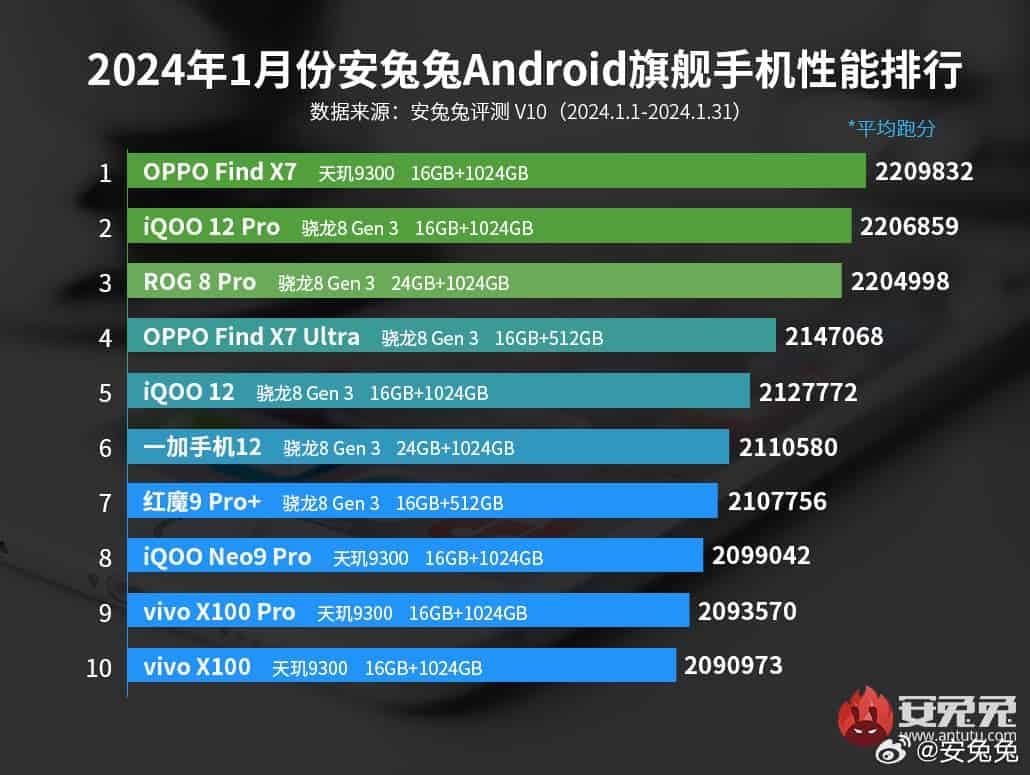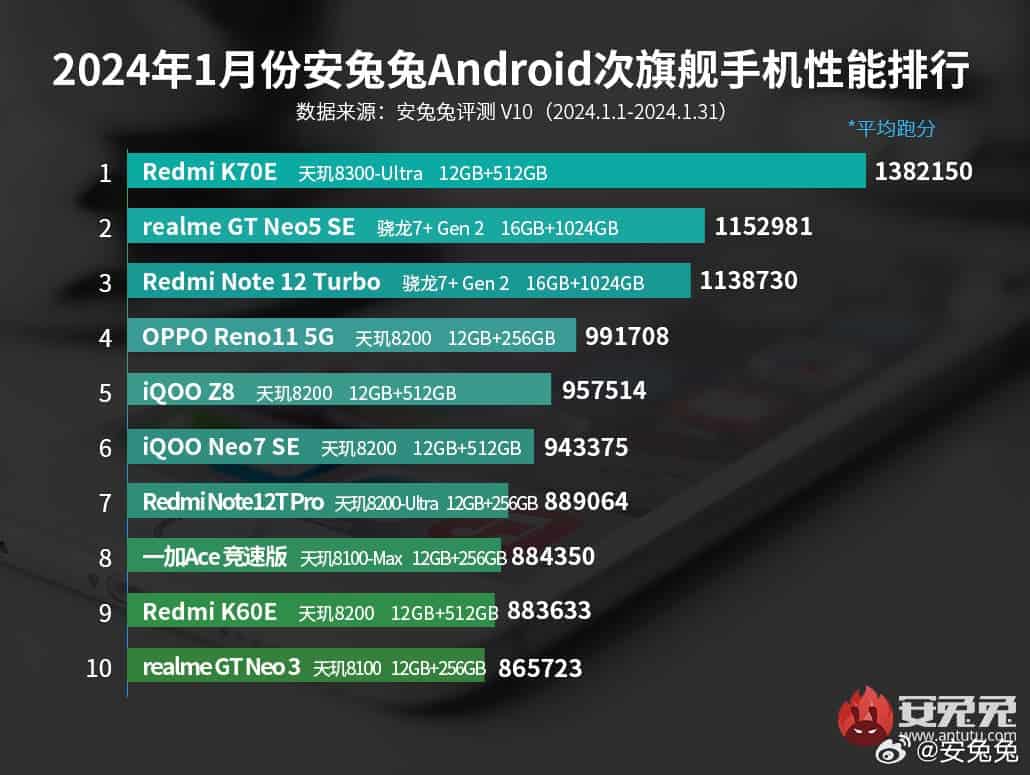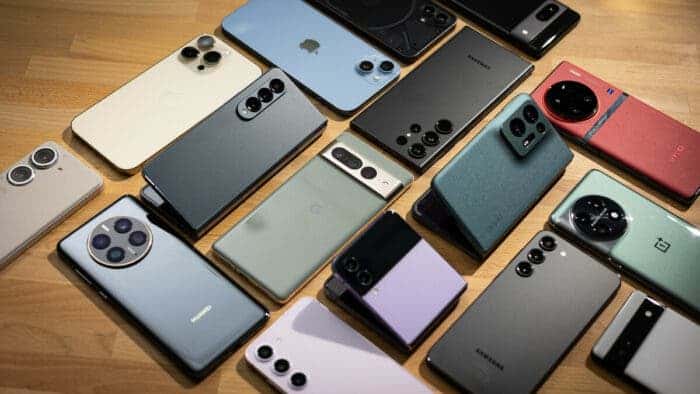AnTuTu, a popular benchmarking platform, recently released its January 2024 performance rankings for Android smartphones. This month, MediaTek chipsets took center stage, occupying the top spots in both the flagship and mid-range categories. However, a closer examination reveals nuances beyond the headline.
AnTuTu’s Top-Ranked Android Devices of January 2024

In the flagship segment, the Oppo Find X7, powered by the Dimensity 9300, emerged victorious with a score of 22,09,932. This puts it slightly ahead of the iQOO 12 Pro (Snapdragon 8 Gen 3) and Asus ROG Phone 8 Pro (Snapdragon 8 Gen 3), which scored 22,06,859 and 22,04,998 respectively. While Dimensity boasts the lead, the margin between the top three is slim, indicating a tight competition between chipmakers. Notably, superior cooling systems in the top performers likely contributed to their edge. Here’s a reminder of the specs of the Oppo Find X7.
OPPO Find X7 specifications
- 6.78-inch (2780×1264 pixels) 1~120Hz adaptive refresh rate AMOLED display with up to 4500 nits peak brightness, 2300 nits peak brightness (HDR), 1600 nits peak brightness (HBM typical), 2160Hz high-frequency PWM dimming, 240Hz touch sampling rate, 2160Hz instant touch sampling rate, Dolby Vision
- Octa-Core Dimensity 9300 4nm SoC with Immortalis-G720 GPU
- 12GB / 16GB LPDDR5X RAM with 256GB / 512GB UFS 4.0 storage
- Android 14 with ColorOS 14
- Dual SIM (nano + nano)
- 50MP camera with 1/1.4″ Sony lytia LYT808 sensor, f/1.6 aperture, OIS, 10-bit HDR, 50MP 119° ultra-wide camera with f/2.0 aperture, 3.5cm macro option, Samsung S5KJN1 sensor, 64MP 3X periscope telephoto camera with ƒ/2.6 aperture, 5P mirror lens, Omnivision OV64B sensor, OIS, up to 120X digital zoom, Hasselblad portrait
- 32MP front camera with Sony IMX709 RGBW sensor, f/2.4 aperture
- In-display fingerprint sensor
- Dust and Splash resistant (IP65)
- USB Type-C audio, Stereo speakers, Dolby Atmos
- Dimensions: 162.7×75.4×8.7mm (glass) / 9mm (leather); Weight: 206g (glass) / 202g (leather)
- 5G SA/NSA, Wi-Fi 7 (802.11be), Bluetooth 5.4, Beidou (B1I+B1C+B2a+B2b), GPS (L1+L5), GLONASS (G1), GALILEO (E1+E5a+E5b), QZSS (L1+L5), dual-antenna NFC, USB Type-C
- 5000mAh (Typical) battery with 100W SuperVOOC fast charging
The mid-range category

The mid-range category saw a more decisive MediaTek victory. The Redmi K70E, equipped with the Dimensity 8300 Ultra, achieved a score of 13,82,150, significantly outpacing the Realme GT Neo5 SE (Snapdragon 7+ Gen 2) at 11,52,981. This suggests a more substantial performance gap in the mid-range, showcasing the potential of the 8300 Ultra. Here’s a reminder of the specs of the Redmi K70E smartphone.
Redmi K70E specifications
- 6.67-inch (2712 x 1220 pixels) 1.5K 12-bit OLED 20:9 display, 120Hz refresh rate, 1920Hz instant touch sampling rate, 3840Hz PWM high-frequency dimming, up to 1800 nits peak brightness, 5,000,000:1 (Min) contrast ratio, HDR10+, Dolby Vision
- Up to 3.35GHz Octa Core MediaTek Dimensity 8300-Ultra 4nm processor with Arm Mali-G615 MC6 GPU
- 12GB / 16GB LPDDR5x RAM with 256GB / 512GB / 1TB UFS 4.0 storage
- Dual SIM (nano + nano)
- Xiaomi HyperOS
- 64MP rear camera with OmniVision OV64B, OIS + EIS, LED flash, 8MP 120° ultra-wide angle lens with f/2.2 aperture, 2MP macro camera with f/2.4 aperture, 4K video recording
- 16MP front-facing camera
- In-display fingerprint sensor, Infrared sensor
- USB Type-C audio, Hi-Res audio, Stereo speakers, Dolby Atmos
- Dimensions: 160.45×74.34×8.05mm; Weight: 198g
- 5G SA/NSA, Dual 4G VoLTE, Wi-Fi 7 802.11 ad, Bluetooth 5.4, Beidou: B1I+B1C, GPS: L1, Galileo: E1, GLONASS: G1, QZSS: L1, A-GPS, USB Type-C, NFC
- 5500mAh (Typical) battery with 90W fast charging
It’s crucial to remember that benchmark scores, while valuable indicators, shouldn’t be the sole purchase decision factor. Real-world considerations like camera quality, battery life, and user interface play equally important roles. However, AnTuTu’s rankings offer valuable insights into raw processing power, a key element for demanding tasks like gaming and video editing.
So, beyond the top spots, AnTuTu’s lists include numerous other noteworthy performers across various price segments. Users can explore these rankings to compare specific models based on their individual needs and priorities.
In conclusion, AnTuTu’s January benchmarks paint an interesting picture of the Android smartphone landscape. While Dimensity chipsets make a strong showing, particularly in the mid-range, the competition remains fierce. For informed smartphone purchases, remember to balance benchmark scores with real-world evaluations and individual preferences.





